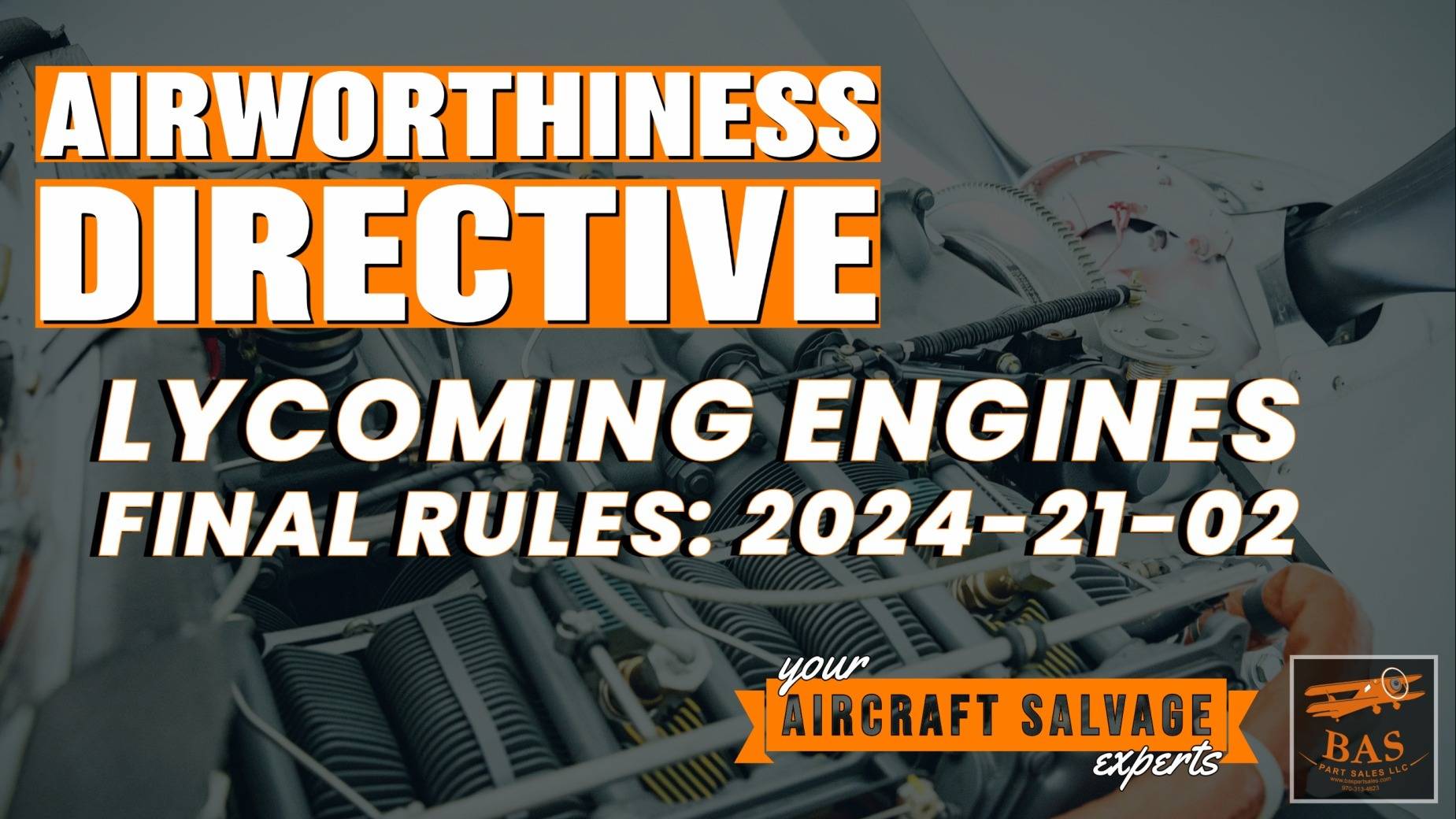New In The Aircraft Salvage Hangar - November 5, 2024
Posted by Clinton McJenkin on Nov 5th 2024

Have a question? Need pictures? Need a part? Need more information or assistance shipping an item? Get in touch...
Call: 970-313-4823
Email: Sales@Baspartsales.Com
Chat: Online or in the BAS Mobile App
Bellanca 17-30 Viking 300
The Bellanca 17-30 Viking, introduced in 1967, was the initial model in the Viking series. Powered by a 300 hp Continental IO-520-K piston engine, it was a four-seat, high-performance, retractable-gear aircraft. This model laid the foundation for the subsequent variants, setting the standard for the aircraft's distinctive flying characteristics and establishing its reputation for excellent handling. The 17-30's design incorporated a single tail, replacing the triple tail of earlier predecessors, while maintaining the large vertical fin that contributed to its exceptional stability and control. Its success led to the development of various versions with different engine options and enhancements, ultimately solidifying the Bellanca Viking's place in aviation history.
This airplane ran off the runway and the owner kept it as a never-ending project. We acquired it in order to disassemble it. Overall, it is in generally good condition considering. We expect to recover a fantastic list of goodies from this aircraft, such as...









Thorp T-211
Despite initial setbacks, the T-211 project saw a resurgence. In the 1970s, following the homebuilding boom, Adams Industries and Thorp Aero subsequently acquired the aircraft rights. Thorp Aero produced five examples, marketed as the Thorp Arrow or T-211 Aero Sport. However, due to liability laws, sales were limited to overseas markets and Part 141 operations. AD Aerospace later undertook kit production in the United Kingdom and Venture Light Aircraft in the United States.
The T-211's story continues with IndUS Aviation's production in India. In the mid-2000s, the aircraft was launched as a Light Sport Aircraft (LSA), becoming the first US-designed LSA to receive FAA certification. A notable evolution involves the engine options: initially, a 65 hp Lycoming was used, then a 90 hp Continental, and later models offered a 100 hp Continental O-200 or a 120 hp Jabiru 3300. The aircraft remained in production as a kit well into the 2010s.
This little bird had a nose gear issue in flight and was forced to land without its nose gear, causing a prop strike. We expect recover a great list of Thorp T-211 parts, such as...









Beechcraft B23 Musketeer
The Model 23-24 Musketeer Super III, introduced alongside the Model 19 Sport, featured a more powerful Lycoming IO-360 engine producing 200 bhp. This model, initially priced at $16,350, offered improved performance. Approximately one-third of production aircraft were delivered with a constant-speed propeller. The Super III's design included a simple heat distribution system, a weakness addressed in later models with improved ducting. The fixed-gear Model 23-24 was produced between 1966 and 1969, succeeded by the Model 24 Sierra. The Sierra, featuring retractable landing gear, enhanced the advantages of the more powerful engine and saw further refinements in subsequent years, including the introduction of the improved B24R and C24R models with increased speed and aerodynamic efficiency.
The Musketeer's legacy extends beyond its civilian success. The Canadian Armed Forces utilized the aircraft, initially with the B23 Musketeer and later with the C23 Sundowner, designated as the CT-134 and CT-134A, respectively. Further development of the Musketeer design culminated in the Beechcraft Model 76 Duchess, a twin-engine aircraft. Though production ceased in 1983, the Musketeer remains a significant aircraft in aviation history, appreciated for its versatility and role as a popular trainer aircraft for many flying schools.
The Beechcraft B23 Musketeer Custom, introduced in 1968, marked a significant step in the Musketeer line. This variant incorporated the Lycoming O-360-A4J engine, boosting power to 180 bhp (130 kW), a considerable increase over previous models. When properly equipped, it received approval for limited aerobatics. The B23 represented a refined iteration of the Musketeer design, showcasing improvements in power and performance, making it a desirable choice for pilots seeking enhanced capabilities within the light aircraft category.
This airplane fell out of annual for too long, and the cost of getting it airworthy again was too much for the prior owner to invest in. It will make a great parts plane, and it will live on keeping the Musketeer fleet in the air for years to come. We expect to recover parts and components, such as...








Reach out and let us know how we can help you get back in the air. 97% of the time, we will ship the same day you order, and on international orders, too - Learn More. Our sales team is available Monday through Friday from 7 a.m. until 4:30 p.m. Mountain Standard Time. The website is open 24 hours a day, 7 days a week.
Have a question? Need pictures? Need a part? Need more information or assistance shipping an item? Get in touch...
Call: 970-313-4823
Email: Sales@Baspartsales.Com
Chat: Online or in the BAS Mobile App
Unrivaled Customer Service: Experience exceptional customer service and get the right parts the first time at affordable prices with one phone call or email to the world leader in aircraft salvage, BAS Part Sales.
90-Day Money Back Guarantee: Guaranteed to work and pass your inspection or your money back. We have the best guarantee in the industry, hands down! Our guarantee has some limitations as we do not accept returns on anything marked CORE, on any fuselage, or any item marked "No Returns Accepted".
Shipping: Our team is ready to get you the best shipping rates possible on every order...and thousands of parts get $5 Flat-Rate US shipping when you buy online. We can quickly combine shipping for multiple items or large items. If you need more information or a specific quote on shipping, get in touch with the BAS team today.
International Buyers: We can ship nearly any part to nearly any destination on Earth. On a daily basis we export aircraft parts to destinations around the world. Some countries have laws and regulations that impact international orders, so get in touch with the BAS Sales Team for answers and details about your international shipping needs.

Clinton McJenkin
Sales & Marketing Director
BAS Part Sales





